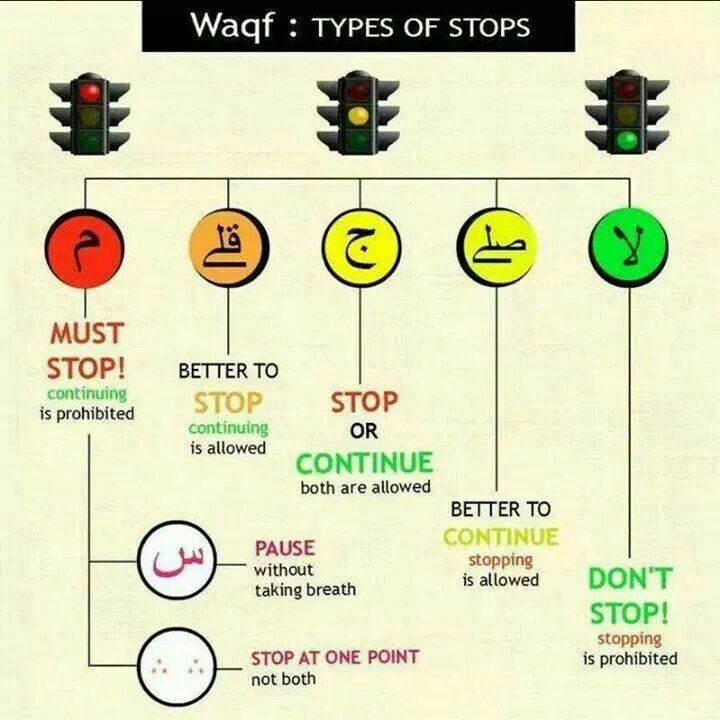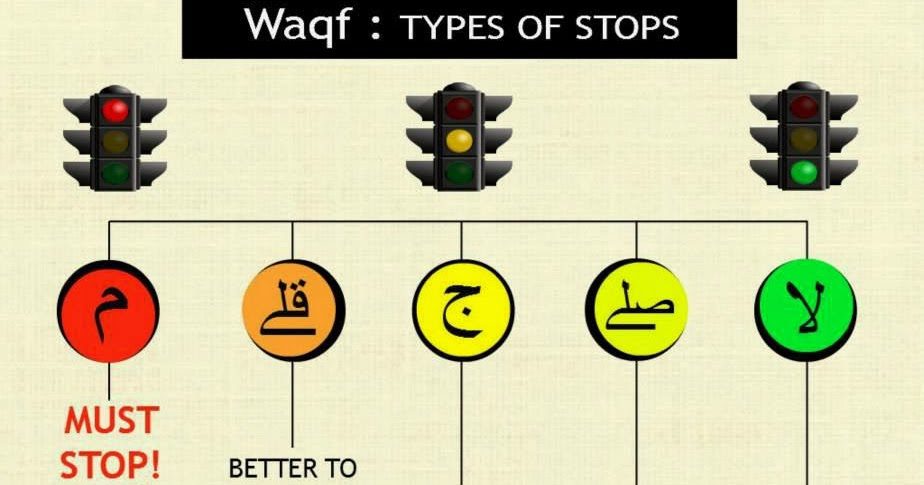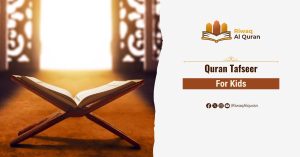The Quran is recited with specific rules for pauses and stops, known as Waqf, to ensure proper pronunciation and meaning. These rules, marked by symbols in the Mushaf, guide reciters on where to stop, continue, or avoid halting to maintain the text’s integrity. Mastering these rules, including understanding symbols like مـ (mandatory stop) and لا (avoid stopping), is crucial for accurate recitation and applying the Quran’s teachings. This attention to detail preserves the sacredness and intended message of the Quran.
Allah SWT revealed the Quran to Prophet Muhammad through Angel Jibreel over a period of approximately 23 years. It is our duty to learn all the Quran reading rules so as to recite it the proper way and apply its teachings to gain the pleasure of Allah the Almighty.
Have you ever reflected on the signs or symbols found above some words? Do you know their importance, meanings, purpose, or how to deal with them? There are rules for stops, pauses, cut-offs, and starts. Let’s learn the rules of stopping when reading Quran and know all the types of Waqf in Quran for better recitation.
Table of Contents
Introduction to Waqf And Ibtida:
Waqf refers to the practice of stopping or pausing during the recitation of the Quran at specified points, either at the end of an Ayah or in the middle of it, to ensure proper understanding and pronunciation. It involves temporarily cutting off the sound to either continue reciting or pause, with the intention of resuming recitation, not finishing it.
Ibtida refers to the act of resuming recitation after a pause or stop, ensuring that the recitation begins correctly from a point that maintains the intended meaning of the text. It involves restarting the recitation smoothly and appropriately, either after a complete or sufficient stop, to preserve the coherence and meaning of the Quranic verses.
When to Stop in the Quran?
First of all, let’s understand the definition of Waqf better before explaining the rules of stopping when reading the Quran. The linguistic definition of doing Waqf is to stop. For its applied definition: It’s cutting off the sound at the end of a word with the intention of returning to the recitation, not intending to finish it. It can be at the end of an Ayah or even in the middle. However, it can never be in the middle of the word.
What are the Quran’s Stop Signs and Symbols?
In the Quran, stop signs are symbols used to guide reciters on where to pause, continue, or avoid stopping during recitation. These signs ensure correct pronunciation and preserve the intended meaning of the verses. Examples include مـ (mandatory stop), ط (normal stop), ج (permissible stop), and لا (avoid stopping).
In the Quran, various Tajweed symbols guide the reader on how and when to stop during recitation:
- مـ (Mandatory Stop): Essential to stop here to preserve the meaning.
- ط (Normal Stop): Appropriate to stop at the end of a sentence or thought.
- ج (Permissible Stop): Allowable to stop, but not necessary.
- صلي (or ز) (Preferable Stop): It’s better to continue but stopping is also acceptable.
- قلي (Preferable to Stop): It’s better to stop, but continuing is permissible.
- لا (Avoid Stop): Indicates not to stop; continue reading.
- قف (Anticipation Mark): Preferable to stop here.
- ∴ (Embracing Stop): Stop at one point if you stop at another point, but continuing without stopping is also allowed.

Note: Some scholars may consider a particular stop good, while others consider it sufficient, and others believe it complete. This comes from variances in conclusions as to the make-up of the grammatical sentence.
Importance of the Rules of Stopping When Reading the Quran
The benefits of learning Tajweed and the types of Waqf and Ibtida are countless. Knowing the proper places to begin and when to stop in Quran is of utmost importance in order not to make fatal pronunciation mistakes or change the entire meaning.
1. Preserves Clarity of Meaning
Correctly stopping in the designated places ensures that each verse conveys its precise and intended meaning as originally revealed, avoiding any possible misinterpretation that could occur from pausing at incorrect points and leading to a clearer, more accurate recitation.
2. Shows Respect for the Quran
Adhering to the Waqf rules demonstrates deep reverence for the Quran’s divine structure and linguistic beauty, reflecting respect and honor for Allah’s words as they were originally revealed to humanity, preserving the sanctity and authenticity of the recitation.
3. Encourages Reflection
Pausing at the appropriate points gives readers a precious moment to reflect deeply on the profound meanings of each verse, fostering a stronger spiritual connection and more meaningful understanding that encourages contemplation and mindfulness of Allah’s guidance.
4. Ensures Smooth Recitation
Observing the correct stops creates a natural, organized flow in recitation that enhances the listening experience, making it easier to follow along and fully comprehend the divine message clearly, respectfully, and accurately as intended.
5. Elevates Faith
Thus, our righteous predecessors were extremely careful in teaching the Ummah all the Tajweed stopping rules. Also, it is well documented in authentic chains that the companions and those that followed them paid great attention to this knowledge.
Moreover, Prophet Muhammad PBUH strongly encouraged us to give the Quran ita due effort and respect saying: “The best among you (Muslims) are those who learn the Quran and teach it” (Sahih Al-Bukhari)
Additional Tools for Dealing with the Stopping Symbols
As a Muslim, it is highly recommended to get equipped with two tools to deeply understand the rules of stopping when reading Quran:
- A general understanding of the meanings in Arabic can keep the reader from most serious mistakes.
- The additional knowledge is gained through the Tafseer (explanation) of the Quran.
However, as a normal Muslim, not specialized in this field of advanced knowledge, or as a non-Arabic native speaker, it could be hard to deal with the above-mentioned topics well.
Thus, as a tool for preserving the meaning of the Holy Quran, certain Quran punctuation symbols and rules of stopping when reading Quran have been added by scholars to the Mushaf designating information about the desirability of stopping in specific places. Mushafs printed in Pakistan follow a slightly different set of symbols from those printed in Arab countries.
Quran Symbols Rules
It is time now to dive deeper into the meaning of each symbol we come across in the Quran and understand the actions required when we encounter them.

As well as the rules of Meem Sakinah, Laam Sakinah Rules, Rules of Laam Shamsiya and Qamariya and other basic Tajweed rules, there are some symbols and rules of stopping when reading Quran that are put by scholars, as mentioned earlier, to help the reciter to stop on a correct meaning. Any point of starting or stopping is considered either permissible, prohibited, or unsuitable according to whether or not it leads to complete and correct meaning. We tried to collect the most common Quran symbols rules, even in the Urdu Mushafs, as follows:
1. Quran Stopping Signs:
- مـ compulsory stop to avoid altering the meaning. It’s an indicator for the required stop.
- ط normal stop at the end of a sentence or thought
- ج permissible stop. It’s an indicator for the sufficient stop.
- صلي (or ز) permissible stop but preferable to continue. It’s an indicator for the good stop.
- قلي permissible to continue but preferable to stop. It could be an indicator for a complete or sufficient stop.
- لا either not to cut off the recitation, or not to stop on the marked word and start on the following word. It’s an indicator of the repulsive stop.
- قف The Anticipation Mark: preferable to stop.
- ∴ – The Embracing Stop: “Mu’aanaqah” is a sign found twice on two words from the Ayah, meaning if you want to stop on one of them, then you are not allowed to stop on the other. However, it’s permissible to continue without stopping on any of them as well.
Note: Some scholars may consider a particular stop good, while others consider the same stop sufficient, and still others consider it complete. This comes from variances in conclusions as to the make-up of the grammatical sentence.
2. Quran Breathless Pause Signs
One of the related topics to the rules of stopping when reading Quran is (Sakt). Sakt or Saktah means a pause held for two counts without breathing during recitation, and it is symbolized by the letter س, in many Mushafs. There are four pauses in the way of Hafs recitation that you can find in Tajweed books.

How to Stop While Reading Quran (Stopping on the Ends of Words)
As well as learning the rules of stopping when reading Quran, It is important to know how to stop on any word. Whether at the end of an Ayah or a phrase, or merely to draw a breath, the following is observed:
- Short vowels including tanween are omitted in pronunciation from the last letter of the word. One exception is the Tanween of Fathah which is pronounced when stopping as an Alif.
- When stopping on Taa Marbutah (ـة or ة) all vowels and Tanween (including that of Fathah) are omitted and the letter is pronounced as Haa with sukoon.
The Start Rules of Reading Quran
After covering the main topics related to the rules of stopping when reading Quran, it is suitable to also tackle how to start. It refers to the resumption of the recitation after cutting it off or stopping it.
The Allowed Start:
It’s allowed to begin with what comes after a complete or sufficient stop under any circumstances. Also, it’s allowed to start with that which comes after a good stop, only if it is the end of an Ayah. You can stop on a correct meaning in the middle of an Ayah, then start your recitation the way mentioned before.
The Not Allowed Start
However, you are not allowed to cut off your recitation in the middle of an Ayah, then start from the middle. Only in this case, you are allowed to cut off at the end of the Ayah. Then later, if you want to start, you will start from the beginning of an Ayah or Surah.
Moreover, you are not allowed to start in a way that changes the intended meaning or changes it. This kind of start could be of utmost repulsiveness if it leads to meaning in disagreement with our creed. If one does this intentionally, he/she will be sinned.
In case of the not allowed starts, Muslim should rather go back till he/she starts from a suitable meaning in the Ayah through which he makes the stop. This is especially when the Ayah is long and it’s hard to come with it as a whole at once.
Note: Most of the above-mentioned information about the rules of stopping when reading Quran is gathered from two books; Tajweed Rules of the Quran by Kareema Carol, Part 3, and An Introduction to Tajweed by Umm Muhammad.
Learn Quran Reading With Riwaq:
With Riwaq Al Quran Institute, You can now enroll in Online Tajweed Course and start learning all the Tajweed rules, including the rules of stopping when reading Quran.
Explore our online courses tailored for all ages and needs. Whether you’re looking to enhance your Quran recitation, start memorization, or delve into Tafseer, Riwaq Al Quran has a course for you:
- Online Quran Courses for Kids
- Noorani Qaida Course
- Online Quran Recitation Course
- Online Quran Memorization Classes
- Online Tajweed Classes for Sisters
- Online Tafseer Course
- Learn Qirat Online Course
Conclusion
The Quran features specific stop signs, or Waqf symbols, to guide reciters on where to pause or continue during recitation, ensuring the preservation of the text’s meaning. These symbols, such as مـ (mandatory stop) and لا (avoid stopping), are marked in the Mushaf to indicate the proper points for pauses.
The different Quran stop signs, like ط (normal stop), ج (permissible stop), and قف (preferable stop), help manage the flow of recitation while keeping the intended meaning intact. These symbols ensure that the reader pauses at the correct moments, fostering a deeper understanding of the verses. They not only facilitate smooth recitation but also allow for reflection and reverence, aligning the recitation with the original structure revealed to Prophet Muhammad (PBUH).
To conclude, after this long journey, you should be patient in reading the Quran. Remember that as long as you exert your effort to learn and improve your recitation, then you are on the track. Success is a continuation. Always keep in mind that learning Tajweed is a gateway for understanding the Quran to apply it. Application is the cornerstone.




































